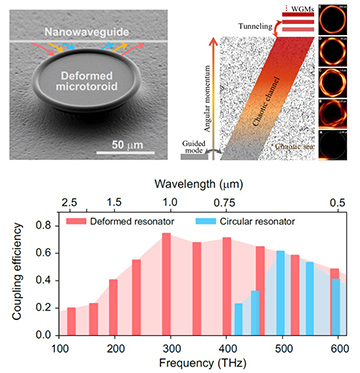 Top left: SEM image of a deformed microresonator coupled with a nanowaveguide. Top right: Schematic for the chaos-assisted momentum-transformed coupling process. Inset: Short-time snapshots in 3-D finite-difference time-domain (FDTD) simulations of spatial intensity distribution. Bottom: 3-D FDTD simulation showing coupling efficiencies of a deformed (red) and a circular (blue) microresonator coupled with a nanowaveguide. [Enlarge figure]
Top left: SEM image of a deformed microresonator coupled with a nanowaveguide. Top right: Schematic for the chaos-assisted momentum-transformed coupling process. Inset: Short-time snapshots in 3-D finite-difference time-domain (FDTD) simulations of spatial intensity distribution. Bottom: 3-D FDTD simulation showing coupling efficiencies of a deformed (red) and a circular (blue) microresonator coupled with a nanowaveguide. [Enlarge figure]
Momentum conservation is one of nature’s fundamental laws, dominating the movements of matter in isolated systems ranging from galaxies to elementary particles. In optics and photonics, this conservation law regulates many interesting physical processes. For example, optical whispering-gallery-mode (WGM) microresonators,1 which confine resonant photons by total internal reflection, traditionally possess rotational symmetry. The total-internal-reflection angle—that is, the angular momentum of a photon in the WGM microresonator—remains constant. Unfortunately, this rules out many desired processes in broadband photonics.
Recently, our team reported broadband chaos-assisted momentum transformations in an asymmetric WGM microresonator.2 We designed a specially shaped asymmetric, or deformed, microresonator to create chaotic channels that transform momenta of light.3 Such chaotic channels, via dynamic tunneling,4,5 can act as a liaison between light in the external couplers and the high-Q WGM resonators, by raising or lowering the angular momenta of light between them in a few picoseconds. As a result, simultaneous broadband coupling of light, from the visible to the near-infrared, can occur between a nanofiber waveguide and a WGMs microresonator—and thus enables broadband momentum transformations of chaotic photons.
We used a full 3-D finite-difference time-domain (FDTD) simulation to demonstrate this momentum transformation mechanism and its dynamics, which enable the effective coupling of WGMs in a silica microresonator over the material’s entire transparent wavelength band (500 to 2500 nm). Experimentally, we realized the momentum transformation process in a nanofiber waveguide coupled to an ultrahigh-Q-factor deformed microtoroid.
This system appears to have significant potential advantages for nonlinear frequency conversions, in applications such as broadband cascaded Raman lasers, third-harmonic generation, and frequency comb generation. Beyond those applications, the proposed momentum transformation scheme could also find use in a large number of other fields—not only multimode lasers, but broadband quantum memories, multiwavelength optical networks, supercontinuum light sources and quantum information processing.
Researchers
X. Jiang, Peking University, Beijing, China, and Washington University in St. Louis, Mo., USA
S.-X. Zhang, L. Wang, Q. Gong, and Y.-F. Xiao, Peking University
L. Yang, Washington University in St. Louis
Linbo Shao and Marko Lončar, Harvard University, Mass., USA
Xu Yi, California Institute of Technology, USA
Jan Wiersig, Otto-von-Guericke-Universität Magdeburg, Magdeburg, Germany
References
1. K.J. Vahala. Nature 424, 839 (2003).
2. X. Jiang et al. Science 358, 344 (2017).
3. X. Jiang et al. Adv. Mater. 24, OP260 (2012).
4. H. Cao and J. Wiersig. Rev. Mod. Phys. 87, 61 (2016).
5. J.U. Nöckel and A. D. Stone. Nature, 385, 45 (1997).
